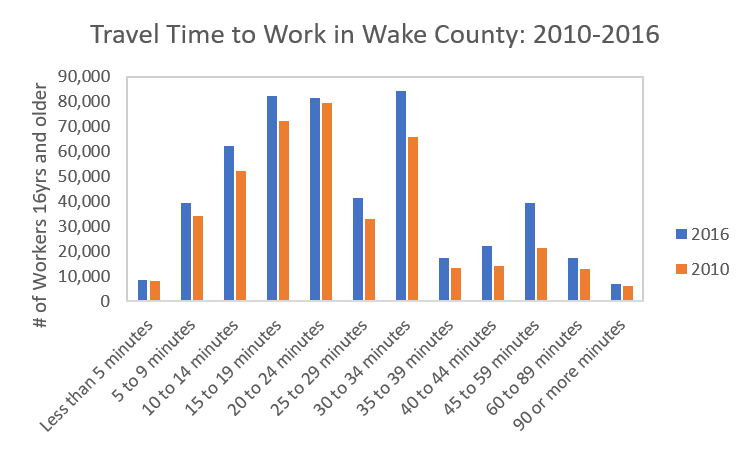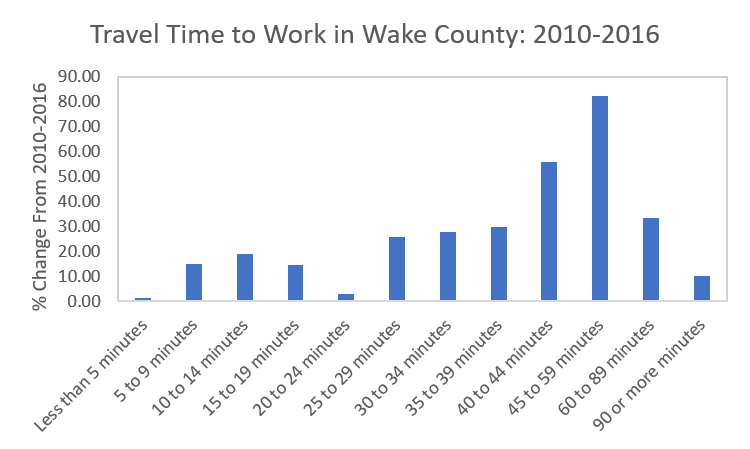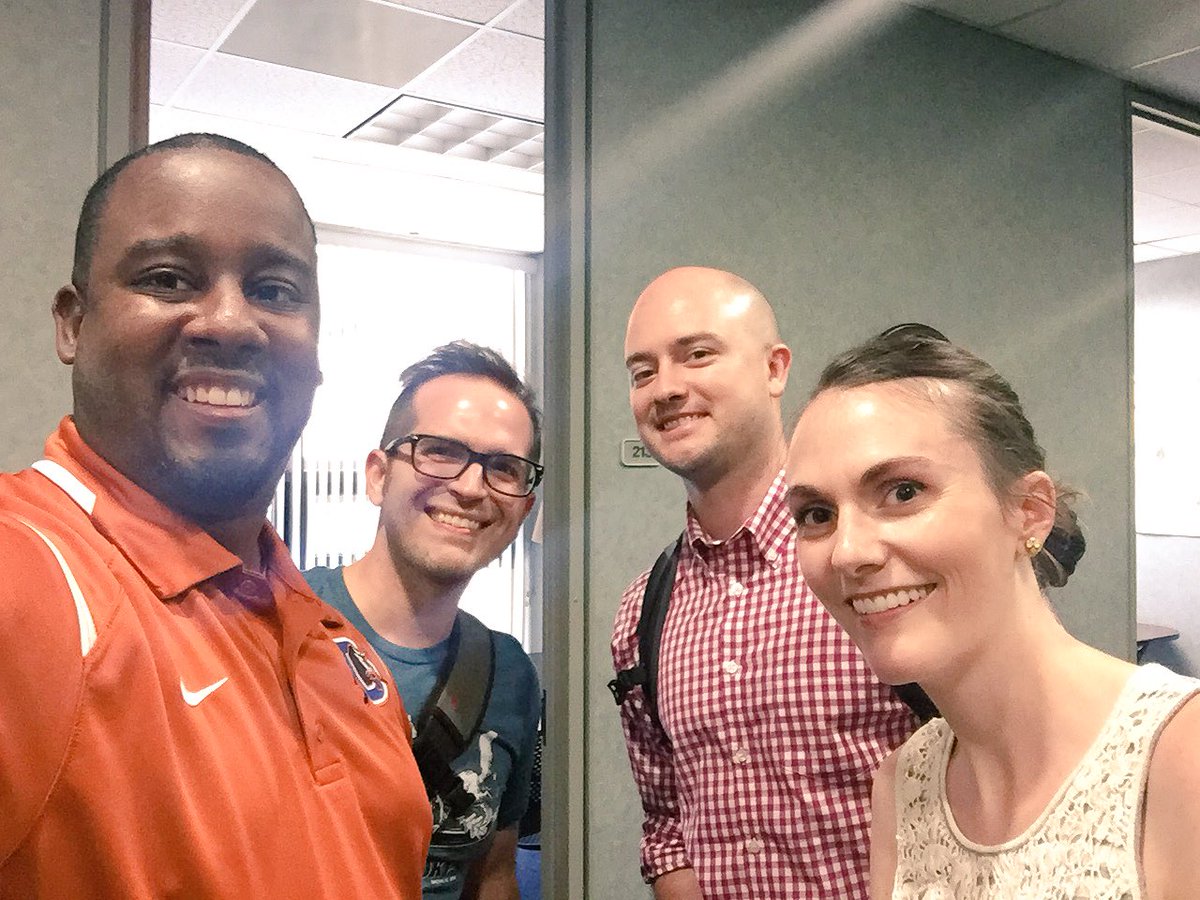The following article was written by Oaks & Spokes member and Advocacy Committee participant, Brian Kurilla.
As Raleigh and Wake County continue to grow, the issue of transit is at the center of public debates and discussions throughout the region. And rightfully so. Even though Raleigh was ranked recently as one of the best cities in the country for drivers, traffic and daily commute times are creeping up as more and more people – over 60 per day – move to the area.
According to the most recent data from the U.S. Census Bureau’s annual American Community Survey, about 88% people who commute to work in Wake County do so using a personal car, truck, or van.
And although the average commute time in Wake County ticked up by only a little over a minute from 2010 to 2016 – from 23.9 minutes up to 25 minutes – there’s been a dramatic and disproportionate increase in the number of workers in the county with long daily commutes.
In 2010, for instance, only 30% of workers in Wake County had a daily commute time longer than 30 minutes. By 2016, that number had crept up to 36%.
Even more striking is that, between 2010 and 2016, there was a full 82% increase in the number of workers in Wake County with a commute time of between 45 and 59 minutes – from 1,495 up to 39,225. In contrast, the number of workers with a commute time of less than 5 minutes increased by a mere 1.1%.

Raleigh And Wake County Transit Plans
Obviously, there’s no simple solution to the problem of traffic and congestion, either in our city or any other. But a serious investment in multi-modal transit is one approach that seems very promising.
Multi-modal transit is an approach to transportation planning emphasizing that residents shouldn’t have to rely on just a single mode of transportation to get from point A to point B. Instead, residents should be able to choose from among many modes of transportation, which all exist and operate together as part of an interconnected network. Cars would obviously be a part of that network, but so too would buses, light rail, bicycles, electric scooters, and even just plain old pedestrian travel.
Fortunately, Wake County residents support multi-modal transit, and, as a result, it looks like we will soon have many more transportation options throughout the city and county.
Indeed, even though only 1.3% of people in the county currently commute to work using public transit, voters approved a half-cent sales tax increase in the fall of 2016 to fund a massive, county-wide effort to better connect communities throughout the region and expand transportation options.
The transit plan, which you can read about here, proposes to expand bus service, improve bus stops and shelters, implement bus rapid transit (BRT) along major corridors into Downtown Raleigh, and build a 37-mile commuter rail system.
Wake county transit plan: http://goforwardnc.org/
The City of Raleigh is also undertaking efforts to expand alternative transit options and is in the process of rolling out its ambitious ten-year priority bicycle plan, which seeks to increase bicycle safety, comfort, and ridership throughout the city.
In 2016, when the plan was adopted, only 0.6% of people in Raleigh commuted to work using a bicycle, according to data from the U.S. Census Bureau. To the extent that few people chose to ride bikes to work because of a lack of safe, comfortable, bicycle facilities, that is all likely to change in the coming years.
By the time the plan is completed, the total amount of bicycling infrastructure in the city – including things like separated bikeways, neighborhood bikeways, bicycle lanes, and greenway trails – is poised to increase by 49%, from 187 miles worth of infrastructure back in 2016 to 278 miles worth in 2026.
Bike plan: http://bikeraleigh.org/home/index.php/planning-design
Oaks, Spokes, And Elected Leader Folks
As a member of Oaks and Spokes, a volunteer-led, non-profit organization that advocates for greater bicycle friendliness in Raleigh, I’m excited to see Raleigh and Wake County make a commitment to multi-modal transit. However, even when the transportation projects described above are complete, there’s still going to be a lot of work left to do to make non-automobile transit a comfortable and viable option for all residents, particularly families with small kids.
As a father of two young boys, ages 6 and 2, I know the challenges that families face when trying to get around the city using a bus, train, or bicycle. There’s no denying that cars are often easier and more comfortable, especially when you’re towing around in the hot summer temperatures a cranky, whiny child who just wants to “finally get home already!”
But it doesn’t have to be this way. Alternate modes of transit can be made comfortable and fun for people of all ages and abilities. But residents and local organizations need to reach out to city officials to share their needs, preferences, priorities, and concerns.
So, this past week, two other members of Oaks and Spokes and I made our voices heard when we sat down and talked about bicycles and transit with Corey Branch, Raleigh’s Mayor Pro-Tem, City Council Representative for District C, and Council Liaison for the Raleigh Transit Authority.
Below is a brief recap of our conversation.
Bicycling And The Challenges of Growth
Joining me in the meeting with Councilor Branch were two other passionate members of Oaks and Spokes – James Demby, an East Raleigh resident and frequent bicycle commuter to downtown, and Mary Sell, an advocate for smart urban growth and commissioner on Raleigh’s Bicycle and Pedestrian Advisory Commission (BPAC).
As soon as he greeted us in his office at the Raleigh Municipal Building, it was clear that Councilor Branch is enthusiastic about engaging with those he represents. I was immediately impressed by how committed he is to listening to and trying to understand all the varied opinions and priorities that exist throughout his district, though it’s one of the largest in Raleigh based on geography.
Most of our hour-long conversation centered around the challenges Raleigh currently faces as a rapidly growing city. Challenges such as increased traffic and congestion, gentrification, and the different – sometimes conflicting – transportation needs across the city’s many diverse neighborhoods. Within this context, we talked specifically about past projects and events organized by Oaks and Spokes, the relative pros and cons of road widening, and the critical role that bicycling can play in a true multi-modal transit system.
Councilor Branch was enthusiastic in his support for all that Oaks and Spokes does for the community – from organizing educational rides for bicyclists of all skill levels to working with the city on various community investment projects – but nonetheless expressed reservations about the realistic impact that increased bicycling can have on city-wide traffic and congestion.
Many residents, he said, live far from downtown and would probably be reluctant to ride a bike into town even with ample infrastructure.
Although the three of us largely agreed with him on this point, we shared that this merely underscores the need for building up greater density and creating additional destination points throughout the city. Having more shops, restaurants, cafes, and grocery stores located in close proximity to where people live would likely be especially helpful for getting young families to opt for bicycles over cars, too, provided appropriate facilities, such as protected bike paths, are in place to provide for adequate safety.
Moreover, we said, if the city were to create a fully connected network of bicycle lanes and bicycle paths in and around downtown, this would encourage more residents who live close to downtown – and for whom bicycling into town is a viable option – to choose bicycles over cars when going out to eat, shop, or work. And if more downtown residents were to ride bicycles rather than drive cars, then this would consequently cut down on the amount of traffic that people living in surrounding areas would have to face when taking a car or bus into town.
Council Branch agreed and shared that his vision for the future of Raleigh is also one where downtown is not the only point of destination.
In the end, we felt it was an extremely productive meeting, and we were all grateful to the Councilor for taking time out of his busy day to talk with us. As representatives for Oaks and Spokes, we look forward to continuing the work and conversation we’ve now started, and we feel confident, given our mutual interests in multi-modal transit, equity, and smart urban growth, that we’ll be able to accomplish a great deal together as our city continues to grow and change.
Personally, I know that bicycling isn’t a silver bullet solution to any of Raleigh’s current challenges. It’s just one piece to the larger puzzle that is multi-modal transit, and one tool in our city’s toolbox for improving transportation.
But given the unique potential of bicycling to promote health and wellness among riders, cut down on environmental and noise pollution, stimulate economic development, connect residents cheaply and efficiently to work and school, and enhance the overall vibrancy of an area, I believe it’s a critical piece to the overall transit puzzle and a tool worth taking advantage of fully.
But then, that’s just my perspective as a volunteer for a local bicycling advocacy non-profit.
Given that a functional local government requires civil engagement among residents from all walks of life, I urge anyone with an opinion – either about transit or any other local issue – to similarly reach out and talk to their own City Councilor.
Source: U.S. Census Bureau, 2016 American Community Survey 1-Year Estimates
